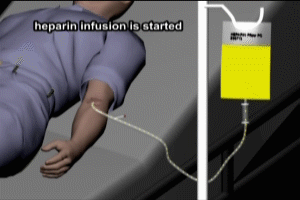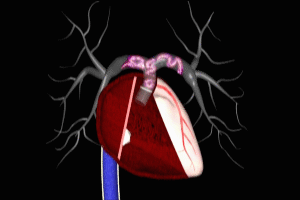Related Article
Related Article
Heparin and Pulmonary Embolism Transcript
Heparin and Pulmonary Embolism
This is Dr. Cal Shipley with a review of heparin: its structure, action, and role in treating Pulmonary Embolism and deep venous thrombosis.
Anticoagulation in Pulmonary Embolism
Heparin is the most common drug used to initiate anticoagulation in individuals with new-onset pulmonary embolism. Unfractionated heparin is a naturally occurring polysaccharide, which consists of molecular chains of varying lengths and weights. Unfractionated heparin has a very short half-life. To be effective, it must be administered continuously by an intravenous drip. Daily monitoring of coagulation function via blood tests is essential when using unfractionated heparin.
Fractionated Heparin
Fractionated heparin was first developed in the late 1990s. It was discovered that through an enzymatic process, the molecules of heparin could be cleaved into smaller fragments. These fragments are of very low molecular weight, hence, fractionated heparin is also known as low molecular weight heparin. The chemical characteristics of low molecular weight heparin provide several benefits when compared to unfractionated heparin in the treatment of pulmonary embolism.
Fractionated versus Unfractionated Heparin
Low molecular weight heparin has a longer half-life than unfractionated heparin. This means that it can be dosed just once or twice daily, instead of as a continuous infusion. Unlike unfractionated heparin, low molecular weight heparin may be administered subcutaneously. This allows home administration by patients in scenarios where outpatient treatment is considered appropriate.
Perhaps of greatest importance, low molecular weight heparin has a very predictable correlation between dosage and anticoagulant effect, eliminating the need for regular monitoring of coagulation function. This characteristic further facilitates outpatient treatment for selected patients with pulmonary embolism. Most studies have shown no statistically significant difference between clinical outcomes in patients using low molecular weight versus unfractionated heparin.
In view of these comparable clinical results and its relative ease of administration, low molecular weight heparin has rapidly become the heparin of choice amongst clinicians, for both inpatient and outpatient use.
Heparin Mechanism of Action
Now let’s look at how heparin works as an anticoagulant. In order to better understand how heparin works, let’s do a quick review of the process of blood coagulation in the human body.
Coagulation in the Human Body
Under normal circumstances, initiation of coagulation is triggered by injury to the wall of a blood vessel. Platelet cells are immediately activated to migrate to the site of injury and plug the hole. Simultaneously, the clotting cascade is activated. The clotting cascade consists of the sequential activation of a series of enzymes, also known as factors. The final step in the sequence is the conversion of soluble fibrinogen into insoluble strands of fibrin.
Clot Structure
The fibrin greatly reinforces the strength of the initial platelet plug. This is the essential structure of a blood clot: platelet cells reinforced by interwoven strands of fibrin. The conversion of fibrinogen into fibrin is facilitated by the enzyme thrombin. One step earlier in the sequence, factor Xa interacts with prothrombin to produce thrombin. It is on these components of the clotting cascade that heparin works to inhibit coagulation.
Unfractionated and low molecular weight heparin differ in their actions on the coagulation cascade.
Unfractionated heparin binds not directly to thrombin but rather to antithrombin, a protein which is capable of inactivating both thrombin and factor Xa. This binding increases antithrombin activity against thrombin a thousandfold and provides a similar boost in activity against factor Xa. Low molecular weight heparin also binds to antithrombin, but increases its activity against factor Xa only.
Heparin and Pulmonary Embolism
The key point to take away from this analysis of heparin’s activity in the coagulation cascade, and this applies to both the unfractionated and low molecular weight forms, is that heparin interferes with the formation of clots, and it has no activity whatsoever in dissolving clots which have already formed.
This then begs the question of what use is heparin in the treatment of deep venous thrombosis and pulmonary embolism? The answer is that heparin is used in the hope that it will stop the formation of new clots and prevent the propagation (extension) of existing clots.
This buys precious time, preventing deterioration of the effected individual’s clinical condition due to increased clot burden while the body’s natural clot busting action, also known as fibrinolysis, dissolves existing clots and re-establishes normal blood flow through the pulmonary arterial system, a process known as recanalization. The process of complete recanalization may take from days to months to occur. Some arteries may remain permanently, partially or completely obstructed despite the passage of time.
In spite of adequate heparinization, new clot formation or propagation of preexisting clots may nevertheless occur, in both the limbs or the pulmonary arterial system, often resulting in catastrophic physiological consequences. In addition, even in the absence of new clot formation or propagation of preexisting clot, anticoagulation therapy does not preclude the possibility of further embolization of fragments from a preexisting DVT.
You can learn more about pulmonary embolism by surfing over to my article, Man Runs a Marathon with a Pulmonary Embolism. You’ll find a link to it on this web page.
Cal Shipley, M.D, copyright 2020


